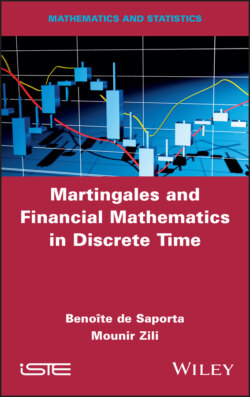Читать книгу Martingales and Financial Mathematics in Discrete Time - Benoîte de Saporta - Страница 6
Оглавление
Introduction
Ever since the work of Black-Scholes-Merton [BLA 73] in 1973, the design, analysis and development of complex financial products and services have required not only an ever-greater understanding of financial theories but also a mastery of probability theory and stochastic processes.
This book introduces basic concepts of this theory, especially that of discrete-time martingales. It shows how this concept can be applied to the pricing and hedging of derivatives in financial markets. There are many texts in the existing literature that focus on financial mathematics and the evaluation of options, for example [LAM 97, SHR 04, VIN 04]. The majority of these texts consider only continuous-time models and make extensive use of Itô calculus. A few rare books such as [SHR 03] introduce discrete-time studies, but this is also done to prepare readers to understand continuous-time financial markets. The most unique feature of this book is that it is entirely devoted to discrete time and provides a detailed introduction to the construction of the rigorous mathematical tools required for the evaluation of options in financial markets. The only pre-requisite for this book is a basic understanding of probability. Several theoretical and numerical aspects are studied in this book, explored through multiple examples and exercises for which complete solutions are provided.
To the best of the authors’ knowledge, this book is the first reference to include both mathematical teaching with multiple exercises that have detailed solutions, focusing on discrete martingales and their application to financial markets, and practical work with solutions, using the software R. Special attention is paid to the Cox, Ross and Rubinstein model in discrete time.
This book is meant for students at the master’s or doctoral level who are specializing in applied mathematics or finance as well as teachers, researchers in the field of economics or actuarial science, professionals working in the various finance sectors, or any other person who may be interested in a rigorous and accessible mathematical construction of the tools and concepts used in financial mathematics or the application of the martingale theory in finance. Finally, the practical work on optimal portfolio management in Chapter 5, as well as the study of American options in Chapter 7, may serve as an elementary introduction to stochastic control problems.
This book is arranged as follows: Chapter 1 reviews the basic concepts and notations in probability and random variables, especially discrete variables, and also provides an introduction to the concept of stochastic processes. Chapter 2 is dedicated to the introduction and study of the concept of conditional expectation, a key concept in the definition of martingales and the computation of financial options. Chapter 3 aims to introduce an interesting example of stochastic process, namely a simple symmetric random walk, with minimal formalism. This chapter may be read as a standalone chapter. Chapter 4 defines and characterizes the concept of a martingale in discrete time and studies certain properties.
From Chapter 5 onward, we focus on financial mathematics, strictly speaking. We define essential financial vocabulary such as the concept of a financial asset, investment strategy and the concept of arbitrage. We also begin to establish a link with martingales. We also introduce a typical example of a discrete financial market: the Cox, Ross and Rubinstein binomial model, which acts as a guiding thread through all the following chapters. In particular, the question of Optimal Portfolio Management in this model is studied through guided work. This is a discretized version of the famous Merton problem, originally posed in the continuous Black and Scholes [MER 69] model. Chapter 6 introduces and studies the first large and specific category of conditional assets, i.e. European options. This is the simplest example of a financial asset which may be exercised subject to the realization of a certain condition. We examine, in detail, the question of the pricing and hedging of these options in the general case of a discrete financial market and then in the specific case of the Cox, Ross and Rubinstein model. Chapter 7 is dedicated to the study of a slightly more complex family of conditional assets: American options. We once again undertake a detailed study of the question of the pricing and hedging of these options and connect them to the theory of optimal stopping, in the general case of a discrete financial market and then in the specific case of the Cox, Ross and Rubinstein model.
The detailed solution to all the exercises and practical work are given together at the end of the book in Chapter 8.
